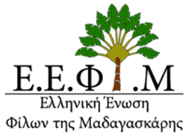The Sapir-Whorf Hypothesis and Shielded Subjects in Malagasy
One of the more heady ideas one encounters in the history of ideas is the Sapir-Whorf Hypothesis (also known as the Whorf Hypothesis, Whorfianism, and linguistic relativism). The idea is that one’s native language dramatically shapes the ways in which one thinks. Whorf’s original emphasis was on grammar; the grammar of a language, he thought, determines the thought patterns that its native speakers are capable of embodying. Because there are significant differences in the grammars of all languages, there is therefore significant differences in the way people think over the world. The differences may indeed be severe, according to this idea. The idea that there is universal thought process that is equally expressible by all the world’s languages is false if a strong version of the Sapir-Whorf Hypothesis is true.
Not many people think that a strong version of this idea is true, but a more qualified one might be. I want to discuss how certain facts about the Malagasy voice system and the current use of voice in Malagasy may explain certain characteristics of the Malagasy people. As such, this is far from a full defense of a strong version of the Sapir-Whorf Hypothesis. I try to draw out how a unique voice in Malagasy not found in English may be part of an explanation for why Malagasy people are typically more reserved and less likely to talk about themselves than Americans. First, I will make some points about voice and then go from there.
English has two voices: active and passive. Here are two examples.
Active: John carried the ball.
Passive: The ball was carried by John.
John is the subject of the sentence in the active voice and the ball is the subject of the sentence in the passive voice. Typically, the active voice is used in English. The passive voice is common if it is not known who the actor is or if one wants to draw attention to the object of the action. For example, if there was a theft and the culprit is unknown, the following two sentences are perhaps equally common.
Active: Someone stole the computer.
Passive: The computer was stolen.
However, in most cases, the active voice is used in English, drawing attention to the actors of actions.
This is not the case in Malagasy; things are typically put in one of the two non-active voices. First, let me explain the three voices. Just as in English, Malagasy has an active and passive voice. There is also a circumstantial or relative voice used when one talks about the circumstances surrounding some action. Consider some examples.
Active: Mitondra baolina i Tovo. (Tovo carries the ball.)
Passive: Entin’ i Tovo ny baolina. (The ball is carried by Tovo.)
Malagasy is also V + O + S in it’s structure, meaning that the verb comes first, then the objects next and then the subject last. The circumstantial voice is used if one wants to draw attention to the circumstances of an action, such as the circumstances surrounding Tovo carrying the ball. This can include any of the following:
- the time he carries the ball
- the place to where or from where he carries the ball
- the manner in which he carries the ball
- what the ball was used to do
- the reason the ball was carried
- how much carrying the ball costs
- the person for whom it was carried
In addition there are some other uses that are orthogonal to the main point here, so I leave them out. One can see that there are many different circumstances related to the carrying of a ball that would trigger the use of the circumstantial voice. There is no such analog in English, though we can say things like the following.
Active: His sister is the person for whom Tovo carries the ball.
Putting things this way, draws attention to the sister and the fact that the ball is carried for her. But no extra voice is used. The sentence is still in the active voice. Not so in Malagasy.
Circumstantial: Ny anabaviny no itondran’ i Tovo ny baolina.
‘No’ is used to invert the normal syntax and display the subject first instead of last in the sentence. It is common to see this use in instances of the circumstantial voice, which like the passive voice has a distinct form of the verb ‘mitondra’. Also, the circumstantial and passive voice in Malagasy both have agent phrases, that is, the marker for the agent is added at the end of the verb. The circumstantial verb is ‘itondrana’ and ‘Tovo’ is added to the end of the verb as above. The same is true of the passive. It is also possible to leave off the agent phrase. If we do so in the above sentence we get.
Circumstantial: Ny anabaviny no itondrana ny baolina.
This means His sister is whom the ball is carried for. The point here is that the actors who perform the actions can get tacked on, as it were, to the end of the verbs that expresses the action. (One might also note that in the normal syntax, the subject comes last and therefore differs from English where the subject comes first, but this does not seem very significant to me.) The use of the agent phases have the effect, I think, of shielding the actor of the action from attention. Yes, the actor is mentioned, but the attention is draw not to the actor but to some circumstantial feature of the action—just as the subject is shielded from attention in the use of the passive voice as well, where the attention is drawn to the object of the action and not the actor who performs it. So, Malagasy has more voices than English, but so what?
I gave the way to say that Tovo carries the ball in Malagasy in both the active and passive voice in my examples above. And from experience it is much more common to hear the passive voice than the active voice. This is not merely a subjective impression, though. Through quantitative analysis, Keenan and Manorohanta (2001) document that the non-active voices are used 10 times as frequently in Malagasy as compared to English. This is a striking fact, and one that no doubt confirms the subjective impressions of non-native speakers. Of course, part of the explanation for this increased frequency is that English is missing a circumstantial voice. However, that is not to the point here. My idea is that the Malagasy language not only has more resources for putting things in a non-active voice but that things are often also put more frequently in a non-active voice. Children grow up internalizing these speech patterns just as their parents did, so they use them too, and thereby shield the actor or performer of the action more so than their counterparts who grow up speaking English. This must be part of the explanation for the fact that Malagasy are more reserved than Americans and less likely to talk about themselves and draw attention to themselves. An excellent book series for learning Malagasy, Malagasy Course for Foreignersby Razafindrabe, Ralahatra and Ravaorimalala, notes, in Volume 1, that “A Malagasy thinks more of the thing which is done than of the agent that does the action. So the passive voice is more commonly used” (105). The point carries over to the circumstantial voice, too. The Sapir-Whorf Hypothesis is relevant here because it is not as if Malagasy people are constantly consciously favoring the passive and circumstantial voices over the active. If they were, they would not be puzzled when you ask them questions about the different voices! In fact, when you talk to most of them about these voices, they will report not having consciously thought about them before—just as I’m sure most English speakers would do if you ask them about the difference between the past tense and the past perfect tense or some other grammar point in English. Malagasy favor using non-active voices in some circumstances because they have been conditioned to use those voices in those types of circumstances. The point is not that they are more passive by nature and therefore consciously opt for the non-active voices. The point is that their relatively more reserved nature (when compared with Americans) is a function of not merely the voicing system of Malagasy but how that voicing system is put to use in practice. It is not as if the reservedness developed independently of the voicing system and its use, and the voicing system gives the resources for a passive people to shield themselves from attention. Rather, the thought and culture was shaped by the voicing system and its use. If that is true, and it seems it is, then some version of the Whorf-Hypothesis is vindicated. There is no doubt more to say about the details. Perhaps it is best to end by saying that difficult is how working all the details out by me will be.
https://www.caseywoodling.com/blog/2017/1/16/c2mme5snl9zuivdb2otzqm7p4mp7wg




